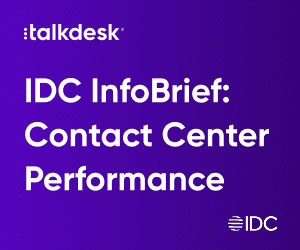Skill-based routing (SBR) has been around almost since the dawn of call centres. Since then, call centres have become multichannel contact centres and the move towards omnichannel communications means that SBR is more relevant than ever.
Skills-based routing is a good thing
SBR enables calls and other contacts to be queued simultaneously to more than one group of advisors, optionally in a preferred order according to a script. SBR routes each call to the first available agent with the requisite skill, regardless of whether that advisor has one, two or more skills, with priority given to specific contact types if desired.
The key benefit of SBR is that it enables centres to get the maximum ‘pooling efficiencies’ from a multi-skilled workforce. The result: customers are more likely to have their issue resolved on the first call, handling time is reduced and advisor productivity is boosted, since there is less idle time between calls compared to a single-skill scenario with a dedicated team of advisors for each call type.
Also, SBR does away with the need to fire-fight by moving advisors from one call type to another to follow differing peaks in workload; the system automatically finds the best resource for the workload mix, in real time.
Having teams of advisors dedicated to each contact type offers no pooling gains. Consequently, for some centres the goal is to train every employee to be a ‘universal advisor’ who can handle any type of call. While this will deliver the maximum possible pooling effect and the greatest schedule efficiency, often it is not realistic. It typically requires weeks of training to achieve proficiency in all the contact types; some calls require a special personality (sales and collections, for example), and the handling of some contact types requires certification that takes months or years to obtain. Staff turnover is a fact of life in every call centre, so in many cases the nirvana of a fully multi-skilled universal advisor workforce can never be reached.
SBR helps centres to utilise staff in a way that may not be fully universal but is certainly more efficient than individual dedicated teams. New hires can be trained on the different call types one by one, progressing once they have demonstrated mastery and gained confidence by handling the calls that are routed to them.
No free lunch
There are, however, some downsides to SBR. Shift swaps need to be handled with more care, since there will be an impact on customer service and efficiency unless agents swap with colleagues who have exactly the same skill combination. The same challenge applies to holidays and overtime. Where seniority-based scheduling is used, senior agents who used to have the best shifts will find themselves bidding against a smaller pool of similarly skilled advisors and may find themselves in unattractive shifts. Last but not least, the complexity of the workforce management (WFM) process is dramatically increased.
One of the biggest challenges that SBR poses to WFM is to determine how many people are needed with each skill or combination of skills. In a single-skill or universal-agent scenario, the Erlang C formula works well. When advisors have a combination of skills, however, Erlang C is completely lacking, since it takes no account of agent skills; it assumes that all agents identical. With SBR, the specific combination makes a big difference since there is a web of interdependencies. For example, hiring staff to have skill X may not seem to address a shortage of resourcing in skill Y. But if there are advisors with skills X and Y, the new advisors will free up those agents to take more calls with Skill Y.
Another challenge is around sickness. We used to know just what to do to backfill for an advisor calling in sick, but now it really matters what set of skills that person has. If the missing advisor has three skills, must we find another person with those same three skills to replace her, or could we make it work if the substitute has only a subset of those skills? It’s easy to imagine a situation for a low-volume queue where we have calls arriving but there is no suitably skilled advisor logged in.
Solutions
WFM software applications approach these challenges in a variety of ways. Some require the user to make simplifying assumptions and handle multi-skilled advisors in the same way as single-skilled agents. Others use sophisticated simulation models that mimic the exact mix of calls in each interval and experiment with different combinations of shifts for the multi-skilled advisors on a trial-and-error basis until a solution is found. These processes can take many hours to run even in a small- to medium-sized centre and with powerful servers.
Simulation relies on accurate forecasting of volume and Average Handle Time (AHT), since it models the arrival of the different contact types in each interval. How accurate is your forecast? Many centres pride themselves on achieving ±5% for the day or week, but may have variance at interval level that is nearer 20%. The smaller the workload for a specific call type, the more likely it is that the variances will be high at the 15-minute interval level.
What about the assumptions about which staff will actually be logged in for any given period? The simulation typically assumes that no advisors will be absent on the day, which is of course over-optimistic. How precise can the simulation be in choosing which advisors will be sick, late or just out of schedule adherence? If the schedules are built weeks in advance, some advisors may have left the business, new ones started and others trained on new skills. Even a schedule for the upcoming week may experience changes as advisors request time off, team meetings are scheduled, and the myriad of day-to-day challenges are managed. The patterns of advisor availability are not easily predicted in many centres.
What if you change the routing logic in the Automatic Call Distributor (ACD)? Many centres make frequent changes to routing rules or ‘vectors’ in response to changing business needs. These changes make the simulation results invalid and mean that the simulation must be reprogrammed – a labour-intensive and time-consuming process.
The simulation makes a number of assumptions that may or may not turn out to be accurate. As the workday begins and the call-arrival patterns turn out to be somewhat different from the forecast, and/or the staff that is in place has a different mix of skills than assumed, it is necessary to rerun the simulation to adjust to the current conditions, and of course those conditions are constantly changing. If the re-simulation process takes a long time to complete, it may not be a practical option to do it as part of intraday management.
Another approach to creating schedules in an SBR environment is the use of sophisticated optimisation algorithms instead of simulation. Optimisation builds schedules that take account of individual advisor skills to an acceptable level of precision in a relatively short time. This speed enables frequent updates to react to changes in the business. Intraday adjustments can be calculated quickly so that staff can be more precisely matched to staffing requirements when the actual workload and staff skill mix is known. While this approach may seem on the surface to be less precise than a simulation process, in the end, the speed with which the recalculations can be done will likely result in an as good or even better match of staff to workload. Since that is the goal of any workforce management process, it makes sense to do it as quickly and easily as possible if the results are as good or better than other methods.
Conclusion
Workforce planning for skill-based environments is often highly complex, requiring the planning team to respond to changes and requests quickly. When an advisor asks for time off in the afternoon, the team needs to be able to determine what the impact is likely to be. If an unexpected surge of calls is received in one call type, planning for overtime or other adjustments will need to be done quickly if it is going to be effective.
When a new product launch causes the AHT to increase, matching the staff to the new requirement is something that must be accomplished quickly. Remember, the main goal of WFM is to put the right number of people with the right skills in their seats at the right time, during as many intervals of the day as possible.
The WFM team has the power to deliver a consistently good customer experience, with optimum utilisation of resources and lower costs, without burning out the advisors. SBR adds a level of complexity to this, but by choosing the right methods and tools, the challenges can be overcome.
Author: Guest Author
Published On: 17th Nov 2016 - Last modified: 12th Jan 2018
Read more about - Archived Content, Call Routing, Peopleware, Skills-Based Routing


























